My Roommate, a Corpse! is Episode 1 (Season One) of the Death in the Afternoon Podcast.
Episode 1: My Roommate, a Corpse!
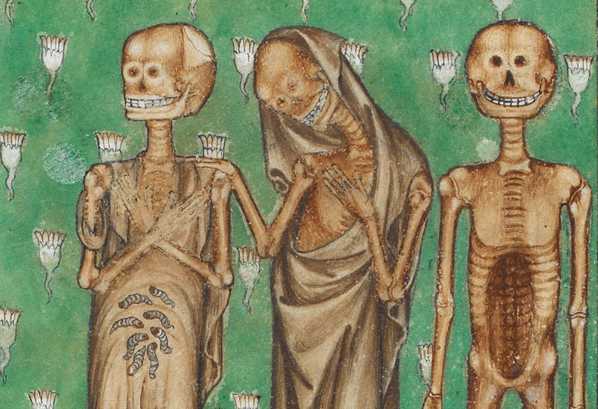
In our first episode we take you on a magical (ok, not always so magical) journey of living with the dead. From an adorable 91 year old lady with a dark secret, to a rhinestone studded cult with resurrection ambitions, to a Japanese mummy collecting government assistance. Buckle up, and welcome to Death in the Afternoon!
When we were developing the podcast an episode about living with the dead was a priority. Although we rearranged the release order for most episodes several times, My Roommate, a Corpse! remained our pick for the first episode.
In the first act, you’ll meet Jean Stevens, who could not bear to part with her husband and twin sister when they died.
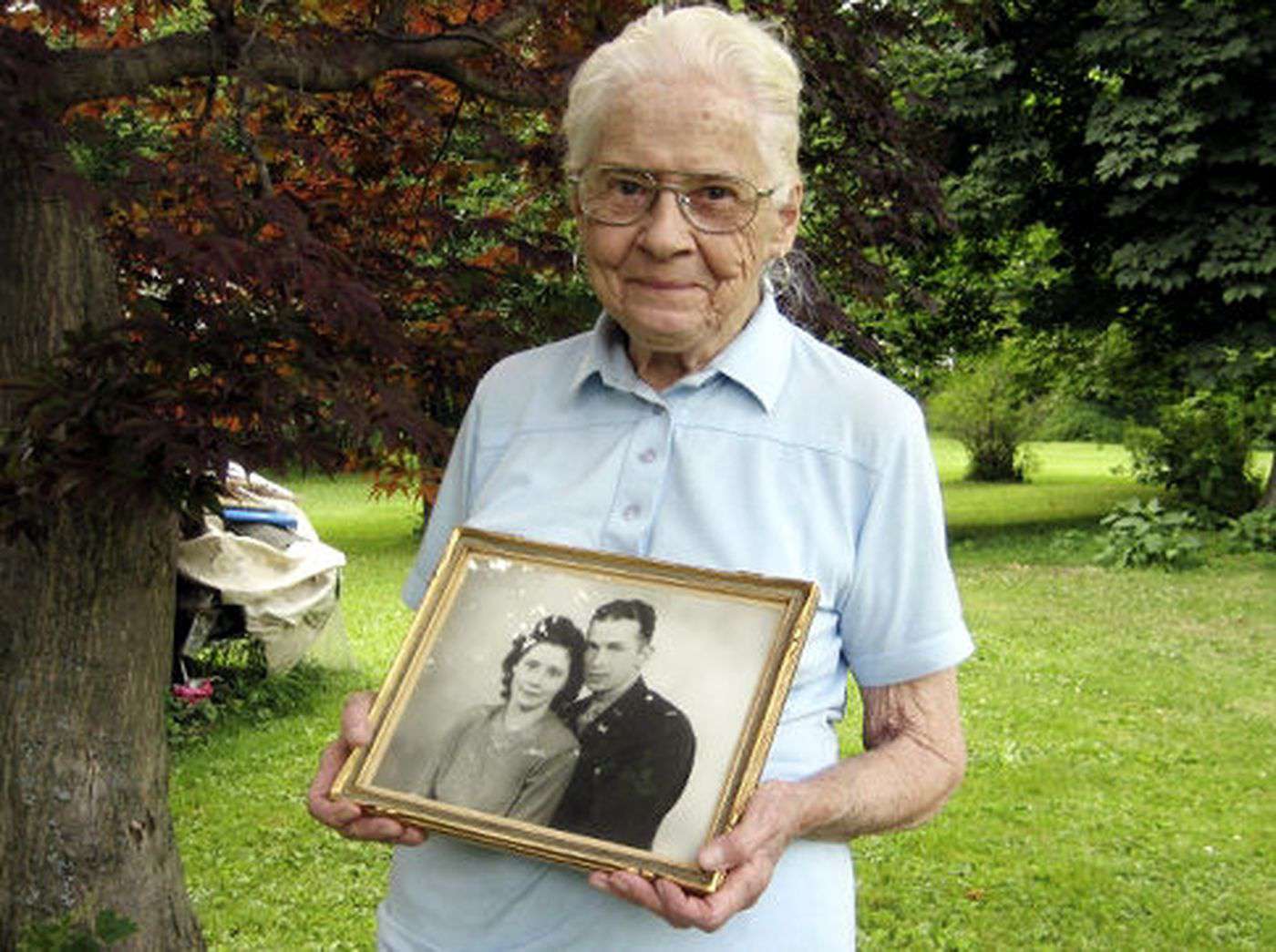
Rubinkam/AP
Jean Stevens holds a photograph from the 1940s of herself and her late husband, James, outside her home in Wyalusing, Pa.
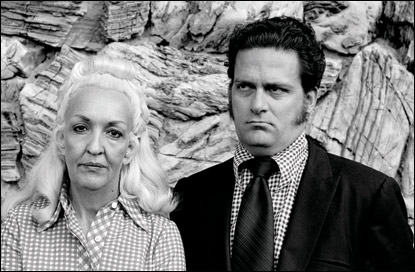
Tony and Susan Alamo.
In Sarah’s segment we hear the bizarre and unsettling tale of Tony and Susan Alamo. One of Sarah and Caitlin’s favorite pieces here on the Order blog was written by Order member and Alamo expert, Greta P. Allendorf, whose piece about the Alamos was the basis for the segment. Unfortunately, we had to remove the piece, but since then we’ve been looking for another way to share the story.
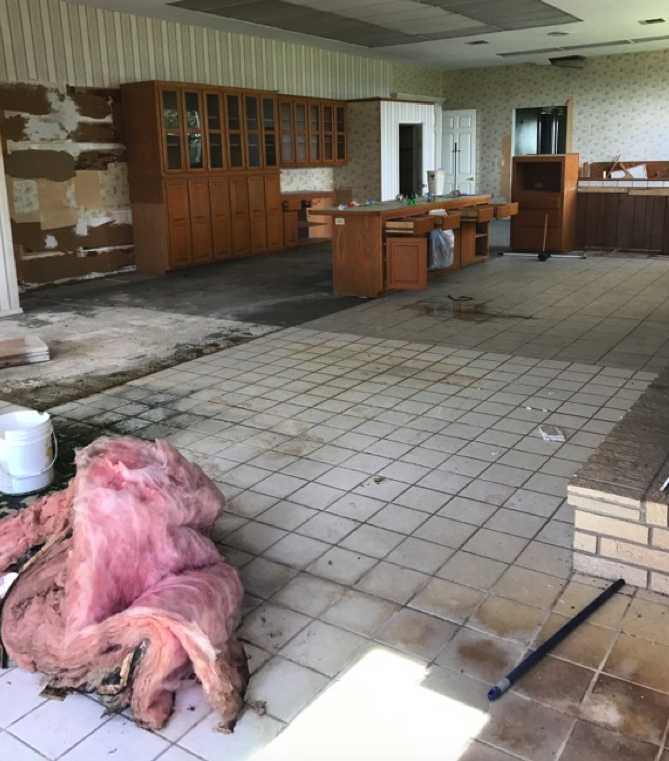
The area in the Alamo compound where Susan’s corpse was displayed for months.
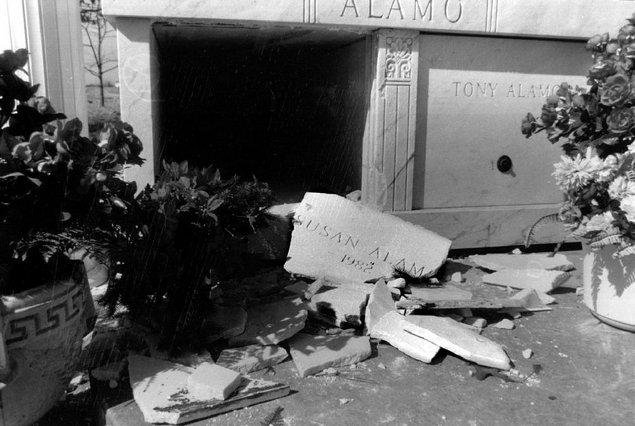
nwaonline.com
The mausoleum Susan was interred in, before her corpse was removed and went on the lam with Tony and other cult members.

A genuine, “groovy,” Tony Alamo of Nashville jacket. You can read more about How Brutal Cult Leader Tony Alamo Amassed A Fortune With Bedazzled Denim Jackets in this piece from Refinery29.
For the final segment of our first episode, co-host Louise Hung shares her thoughts about lonely deaths, the aging population in Japan, and Kato Sogen.
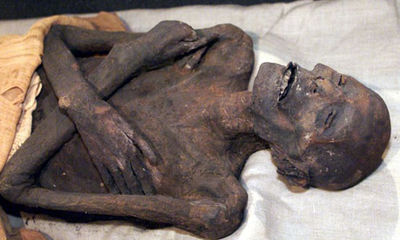
The mummified corpse of Sogen Kato.
Here’s Louise:
Whenever I’ve researched the senior citizen population in Japan and lonely deaths, I’ve found the experience to be both fascinating and heartbreaking. Contemplating an entire generation, potentially several generations, that must confront the reality of dying a lonely death is sobering. While I am not Japanese, I only lived there for a few years, thinking about lonely deaths or even hidden corpses in Japan always makes me think of an apartment building on the outskirts of the rural town I lived in for a time.
Far from the train tracks and main road, tucked against the wooded mountainside, there was a graying building that rose taller than the rest. I often rode my bicycle by the building in the afternoon when I had to get away from my computer. Its size was daunting, but it also seemed to shrink back. Really, I didn’t like to look at it but I couldn’t look away. I wonder if the whole town felt that way. Though there was a playground nearby, I never saw children play there. The seesaws were brightly colored but the mouldering building seemed to cast a pall on it. I only saw old women come and go from the building.
Hunched, tiny women walked the overgrown concrete path from the road to one of the many of dim hallways that lead to concrete inner staircases. Some had cramped ground floor flats with sliding glass doors that occasionally revealed crowded homes with tatami mats, mounds of papers, and plants. Often a small, old TV.
The building always looked gray and old. Like its inhabitants? I rode by that building several times a week and never saw any people who you wouldn’t feel obliged to carry groceries for or give a seat up to on the train. When I think of lonely deaths, an aging population with nobody but themselves, their mortality, and the other solo individuals around them, I think of that building. I wonder how many Kato Sogens or “missing centenarians” have dwelled there in life and in death.
Edisode 1 Transcript
[00:00:00] [Music plays. Soft string music in background.]
Caitlin: [00:00:01] This story is about a family. Jean Stevens, at 91 years old, lived with her husband James and her twin sister June in Wyalusing, PA. Wyalusing is a small town, population 565.
[00:00:17] Jean and James were married in 1942. Now, Jean loved her husband, but in many ways she was closer to her twin sister. Even all the years the women lived apart, they talked on the phone and wrote each other constantly. They were so close they even married a pair of brothers.
[00:00:37] Now Jean, June, and James all lived together, in a house down a rural road in Wyalusing. Jean was the caretaker of the group. Her husband spent most of his time on the couch in the garage. Her sister lived in the spare room.
[00:00:53] There was no problem with this arrangement until one day the state police were tipped off to visit the property. Someone had accused Jean of violating health codes and misdemeanor abuse. Not elder abuse… abuse of a corpse. You see, James, her husband, and June, her twin sister—were both dead. James for ten years, June for a year. And Jean? 91 year old, still-very-alive Jean? She wasn’t going to give them up without a fight.
[00:01:31] [Death in the Afternoon theme plays.]
Caitlin: [00:01:39] Welcome to Death in the Afternoon, a new podcast about all things mortal from The Order of the Good Death. Over the next eight episodes, we’ll explore the reality of death, the funeral industry, and what we do with our dead. We’re going to introduce you to stories you’ve never heard before as well as try to convince you to let go of myths you’ve heard again and again. I’m Caitlin Doughty. You might know me as Ask the Mortician or from my books, Smoke Gets in Your Eyes and From Here to Eternity. I’ll be joined each episode by peak death nerds Louise Hung, my research and writing partner, and Sarah Chavez, executive director of our org, The Order of the Good Death. This is our first episode of our first season. We’re calling it My Roommate—A Corpse.
[00:02:25] [Music continues.]
Caitlin: [00:02:32] Okay, I’m bringing in Louise. Say ‘Hello’ to the fine people, Louise.
Louise: [00:02:35] Hello, it’s me, Louise.
Caitlin: [00:02:37] What do you remember about the case of Jean Stevens?
Louise: [00:02:40] Well, I remember that she kept her dead sister and her husband and lived with them at home.
Caitlin: [00:02:46] Yeah, that’s Jean.
Louise: [00:02:48] But you know what I also remember is that I kind of related to Jean. Not that—not that I’m gonna live with my dead loved ones, but I could really see myself getting into a headspace where because of fear and loss and loneliness that I wanted to find a way to thwart the finality of death.
Caitlin: [00:03:08] Well, there was this outpouring of sympathy for Jean, from everyone. People were really on her side. Which, to me, is completely unexpected, in America, in 2010, when someone is found to be living with multiple corpses in their home.
Louise: [00:03:23] Right, I mean, it was pretty amazing. Do you think it had anything to do with how the media portrayed her as sweet and unassuming?
Caitlin: [00:03:32] She seemed like the nicest old lady that ever was a nice old lady. There were pictures of her taken by the Associated Press where she’s lovingly holding a picture of her and her husband from the 1940s. She’s got her poofy white hair in complete sweet grandma mode. Apparently, when the reporters went out to interview her she literally offered them slices of pie.
Louise: [00:03:56] Aww, Jean! I’d eat pie with her.
Caitlin: [00:04:01] And then, when the reporter declined she said, “You’re afraid I’ll poison you.”
Louise: [00:04:07] God, she wouldn’t poison them. Why do people always think that anybody who’s been around corpses must have murdered them. It’s that whole Norman Bates, Jeffrey Dahmer school of thought.
Caitlin: [00:04:20] And to be clear, in this case Jean did not murder her husband or her sister, she just… missed them. So after a while she had them dug up.
Louise: [00:04:29] So what do you think made Jean different? A lot of people miss their dead family members terribly, but they don’t go dig them up and put them in the living room.
Caitlin: [00:04:37] Well, doesn’t that just make Jean more motivated? More driven to exhume? Willing to follow her dreams of reunification?
Louise: [00:04:45] Do we know why she did it?
Caitlin: [00:04:47] So, the first reason, which is pretty sad, is that both her and her twin sister were severely claustrophobic. And Jean felt like, even though June was dead, she was still trapped down in the ground, in her casket, suffocating.
Louise: [00:05:02] Do we know what she thought about cremation?
Caitlin: [00:05:05] We don’t. That’s unclear, although that would have been a good solution for that. And to be honest with the whole casket thing, I sort of agree with her. Being trapped in a casket underground freaks me out.
Louise: [00:05:16] Totally. I am right with you and Jean in that regard. What’s the second reason?
Caitlin: [00:05:21] She wanted to be her husband and her sister’s caretaker, and provide care to their bodies. She put June in her best housecoat, sprayed perfume on her, put on her glasses, made her face all nice.
Louise: [00:05:35] Okay, so June was embalmed?
Caitlin: [00:05:37] Oh, uh, yes. 100%. June would have been a bloated mess in a few weeks without the chemicals of embalming. I imagine she didn’t look great as it was, it probably had a sort of mummy vibe to the twin sister, but she wasn’t down to a skeleton either.
Louise: [00:05:56] Okay, and her husband was in the garage?
Caitlin: [00:05:59] In the garage, in his best suit and tie. Here’s a quote from Jean, “I could see him, I could look at him, I could touch him. Now, some people have a terrible feeling, they say, ‘Why do you want to look at a dead person? Oh, my gracious. Well, I felt differently about death.”
Louise: [00:06:18] Oh, my gracious. You’re Team Jean, aren’t you?
Caitlin: [00:06:20] I am Team Jean, and you’re all gonna be Team Jean, too by the time we’re done. Listen, I’m sad that she was in so much pain. Her grief is palpable and likely stunted, which made it hard for her to move on. But I’m also an advocate for home funerals, which is where the family takes care of the body at home before the burial takes place. And sometimes I wonder if people with stunted grief like Jean, maybe she might have been helped by being allowed to take care of James and June before they were buried. And, either way, they were her next of kin, so, she should get to make that choice.
Louise: [00:06:58] Alright here’s the big question: did Jean go out to the cemetery in the middle of the night with a shovel? I mean, how did she get them?
Caitlin: [00:07:07] This info, it didn’t come out right away. We didn’t know when the story broke. Only later, it’s revealed that misdemeanor charges are filed against James Flanagan, a neighbor, 62 years old.
Louise: [00:07:20] Ah yes, a strapping young lad of 62. At least to a 91 year old woman.
Caitlin: [00:07:25] Right, a 62 year old neighbor admitted he dug up June’s body as a favor to Jean. And this was made easier by the fact that June was already buried in Jean’s backyard.
Louise: [00:07:37] So instead of mowing your lawn for your neighbor you dig up a body for your neighbor? Ah, those simpler times…
Caitlin: [00:07:44] These are the small town values that liberals are trying to take away.
Louise: [00:07:47] Apple pie and exhumations. So, what about her husband’s body?
Caitlin: [00:07:52] Apparently, the police knew who exhumed James from the cemetery, but it had been ten years so the statute of limitations on what they call, “abuse of a corpse” had expired. Meaning they could no longer go after the person.
Louise: [00:08:08] All right, you said that earlier. What does abuse of a corpse mean?
Caitlin: [00:08:11] I am obsessed with abuse of corpse laws. Not that it’s funny to abuse a corpse, obviously, but the interesting thing to me is that the definition varies wildly from state to state and is ridiculously vague. For example, in Pennsylvania, that 62 year old guy who dug up June would quote, “outrage ordinary family sensibilities.”
Louise: [00:08:34] What does that even mean?
Caitlin: [00:08:35] Exactly. It does mean anything. It’s completely arbitrary. In the past something like being gay or an interracial relationship would “outrage ordinary family sensibilities,” it’s based on these very subjective value judgments.
Louise: [00:08:49] I feel like we, as a culture, get so fixated on the acceptable ways to handle the dead. Essentially, out of sight, out of mind. So, we forget that death and mourning can look wildly different for different people and different cultures outside of our own.
Caitlin: [00:09:04] I bring up the mummies of South Suluwesi, in Indonesia all the time, but they are such a perfect example to Jean’s situation. There’s this very rural area in Indonesia where the family live with the embalmed dead bodies of their loved ones for years in the same house. They will dress the family member, talk to them, even sleep in the same bed with them. They are comforted by the presence of the dead. Pretty much exactly what Jean Stevens was doing with her husband and sister, except there it’s culturally sanctioned, and here, it’s a crime that can “outrage ordinary family sensibilities.”
Louise: [00:09:42] So, did they ever end up charging Jean Stevens with a crime?
Caitlin: [00:09:46] They didn’t. And, good for Jean. Good. And what makes this story so weirdly heartwarming, is that instead of headlines like “CREEPY GRANDMA OBSESSED WITH THE DEAD” everyone was pretty much on her side, like, the coroner, the police, the public. She wasn’t a recluse. People were coming to visit her all the time, bringing her groceries and hanging out while she had the bodies in the house.
Louise: [00:10:11] And they had no clue about the bodies? Do you think they were turning a blind eye?
Caitlin: [00:10:16] Maybe they were, maybe they did know about the bodies. Who knows? What happens in Wyalusing stays in Wyalusing, Louise.
Louise: [00:10:21] Okay, so how then did anyone ever find out?
Caitlin: [00:10:24] Well, Jean thinks that a relative of James, her husband, called and reported it. She said about this, quote, “I think that is dirty, rotten.”
Louise: [00:10:36] That is dirty, rotten. So, how did things end for Jean? And the corpses?
Caitlin: [00:10:42] Well, for a while, back in 2011, there was talk that Jean was going to have a small above ground mausoleum built on her property and the coroner was willing to give her back the bodies as long as she had them sealed in something, like glass top caskets or clear paneled body bags.
Louise: [00:11:01] So it was all wink wink, “They’re not in your house, they’re in this tiny house in your yard, it’s a mausoleum. And you have to have them sealed, but you can go in there whenever you want and see them and hang out.”
Caitlin: [00:11:13] It’s a good workaround, I think. But the trail kind of dried up as to whether that happened because it wasn’t in the news anymore. So, the information I have comes from, bless their hearts, Find a Grave.com, magical cemetery resource. Jean, as it turns out, died in 2012, at 92 years old, which was about a year and a half after all this happened. And she’s is buried in Lime Hill Cemetery in Pennsylvania. And when you go online, you look at pictures of the cemetery and there are all these very normal looking headstones, the nice flat manicured green grass, and then all of a sudden, totally out of style in the cemetery, there’s this big rectangular above ground crypt. Like a box coming out of the ground. And in it, is Jean, June, and James.
Louise: [00:12:02] Oh, I love that they’re all together. Triple J forever.
Caitlin: [00:12:05] Even better, when Jean died, neighbors purchased this above ground crypt for them, so June and Jean, who were claustrophobic, wouldn’t have to be underground.
Louise: [00:12:15] Aw, everyone is Team Jean! It’s not just you.
Caitlin: [00:12:18] I told you. You’re Team Jean now too. You’re welcome.
[00:12:20] [Music plays.]
Caitlin: [00:12:28] I wanted Sarah Chavez to be a part of this podcast because I think she’s a fantastic storyteller who has had a wonderfully bizarre life, as you’ll learn more about as the season goes on. And when you have a wonderfully bizarre life, you know how to spot a wonderfully bizarre story. Like the story of Tony Alamo, his wife Susan, and their church, well, cult, it was a cult, really.
[00:12:56] [Music plays.]
Sarah: [00:13:00] This story has everything. A boy who wanted to be Elvis, a girl with a bleached blonde bouffant, a stolen corpse, and the mind-altering power of Jesus Christ—all encrusted in rhinestones.
[00:13:13] Tony Alamo was born Bernie Lazar Hoffman in 1934, in Joplin, MO. He claimed his father, a Jewish immigrant from Romania, had been a dance instructor for silent film star and sex-symbol, Rudolph Valentino. As a teen, Tony left Missouri for Los Angeles to find fame and fortune in the music industry.
[00:13:39] He recorded a single “Little Yankee Girl” that’s, well, judge for yourself:
[00:13:43] [Music: Little Yankee Girl by Tony Alamo] ”Little Yankee Girl over there. Little Yankee Girl, would you care if I should kiss you or hold you tonight. Little Yankee Girl…
[00:13:58] But mostly, Tony just talked big, telling anyone who would listen that he was a hotshot music promoter who’d worked with superstars like The Beatles and The Rolling Stones.
[00:14:10] And that’s how Tony met Susan.
[00:14:14] Susan was born Edith Opal Horn, also of Jewish descent, in Alma, Arkansas. She had moved to Hollywood to become an actress, but was supporting herself in the meantime scamming churches.
[00:14:28] “Put your dress on,” she would tell her daughter. “We’re gonna do a church.”
[00:14:34] The two were married in 1966, three times in a period of two days. According to a 1980 court deposition, Susan stated that the couple was first married in Mexico. But he worried that their marriage wasn’t legal and refused to consummate the marriage. Later that day, a frustrated, Tony supposedly bought not one, but TWO marriage licenses in Las Vegas, and they were married another couple of times—just to make sure it stuck.
[00:15:04] If marrying Susan wasn’t serendipitous enough, within the same year Jesus himself appeared to Tony to personally inform him that it was his mission to tell the masses of the second coming of Christ. So, the newlyweds built Music Square Church in Hollywood and began bringing the hippies of California into their fold.
[00:15:29] The Alamo ministry preached a range of ideas; end times paranoia, UFOs and aliens as divine messengers, and a lot of Vatican conspiracy theories. Even Man’s Best Friend couldn’t be trusted, asTony insisted dogs were, “Evil beings that could weaken children’s hearts.” Followers flocked to worship with the charismatic Alamos, and the church grew into its own compound in Saugus, California. Members of Music Square Church would live communally at the compound and work at various Alamo-owned businesses, which they believed they had to or Tony would use his special powers to send them to hell. When payday came, they’d return their paycheckto Tony, who would then give it to Jesus—or, so he said.
[00:16:25] Tony and Susan were now on top of the world. They were in love, rich, famous and rulers their own empire.
[00:16:37] Then, in 1975, Susan was diagnosed with cancer. Her diagnosis didn’t actually phase them much, as the couple TRULY believed themselves to be immortal. “I am the Lamb of God,” Susan would say on their television program. Yes, their television program.
[00:16:58] The program was an unpolished, evangelical variety show – Tony sang songs in bedazzled suits, while Susan stumbled through sermons and testimonies dressed in a polyester gown and tiara, all the while reminding viewers that she was Tony’s biggest fan.
[00:17:18] As a child, in Arkansas, Susan had suffered from tuberculosis and was on her deathbed, when suddenly she was visited by angels and miraculously healed! When Susan shared the story of thehealing power of Arkansas with Tony, they packed up their furs, turtle leather platform boots, Bibles,diamond pinky rings, and crew of followers in a fleet of black Cadillacs and headed toward Dyer,Arkansas, population 486.
[00:17:52] In Dyer, the Alamos moved into Susan’s miraculous childhood home and began remodeling it with materials shipped in from Hollywood—blood red carpeting, gaudy chandeliers, and velvet wallcoverings.
[00:18:07] They also began construction on a sprawling Victorian home on the hill, complete with dormitories for their followers and a red, heart-shaped pool just for Susan. A grand church hall wasconstructed nearby so they could continue to record their TV show, where Tony would add to hisusual repertoire of gospel songs, by serenading his ailing wife with songs like,“I Love You SoMuch It Hurts Me.”
[00:18:37] The Alamos also set their sights on expanding their empire in the neighboring town of Alma. Once it was all said and done, the Alamos owned 30 businesses in a town of 30,000, including a supermarket, western store, restaurant, a candy factory, and hog farm. In President Bill Clinton’s autobiography My Life, he talks about a trip he made to the Alamo restaurant to see Dolly Parton perform and describes Tony Alamo as “Roy Orbison on speed”.
[00:19:13] In 1982, despite Tony’s orders for intense prayer, Susan’s cancer worsened. She died on April 8th at a local hospital. A devastated and shocked Tony blamed his church members for not praying hardenough. Luckily, they had immortality on their side and a Plan B.
[00:19:38] Susan would rise from the dead. Tony was sure of it.
[00:19:46] So, instead of burying Susan, Tony brought her embalmed body, dressed in her wedding gown, as Susan was “The Bride of God,” back to their home. He had her corpse placed in the dining room and ordered his followers to surround her 24 hours a day, to pray for her resurrection. A local florist was hired to deliverflowers to Susan almost daily.
Elishah Franckiewicz grew up in the cult. In a 2008 interview with The Oregonian, she recalled Susan’s death. “I believed 100% that she was going to rise from the dead.” Tony talked publicly about the resurrection and localradio stations made fun of him by playing “Wake Up, Little Susie” over and over. Franckiewicz, said that week after week, they would be forced to lay down and curl upwith Susan’s decaying corpse.
Quote: “She smelled. She was cold and really, really hard. She was dead.”
[00:20:48] Eachday that Susan remained dead, the children were punished by being beaten. Quote: “We prayed over heropen coffin for months. When she didn’t come back to life, Tony started losing his mind. Hebelieved that it was because the devil was in the children, because we had weak souls.”
[00:21:12] After 6 months of constant prayer, an exhausted crew of cult members finally placed Susan in anewly constructed mausoleum on the grounds. Franckiewicz was devastated and remembers layingon the mausoleum, still praying for Grandma Susie to rise.
[00:21:32] Grief stricken, Tony Alamo did what any heartbroken evangelist would do. He created his own fashion line. High on coffee, vitamins, and Jesus, Tony’s cultmembers and their small children would work until the wee hours of the morning, sometimes untiltheir fingers bled, bedazzling denim jackets with elaborate, brightly colored cityscapes of rhinestones andSwarovski crystals.
[00:22:02] “We really thought we were making these jackets for God. We did it with zeal,” shared Benjamin Risha, who grew up in the Alamo’s ministry.
[00:22:11] These jackets would sell for anywhere from $600 to $5,000 and graced the backs of celebrities like Burt Reynolds and Michael Jackson.
[00:22:22] With the love of his life temporarily interred, Tony also remarried, multiple times. First, he tried his hand with a couple of 15 year-old girls. When that didn’t pan out, he married Birgitta Gyllenhammar.
[00:22:40] Two years later, she left him, claiming that he tried to force her into getting plastic surgery to look like Susan.
[00:22:47] Up to this point, Tony had charmed his way out of various legal troubles. In 1991, the law finally closed in on the Alamo Foundation and charged him with tax evasion. Prior to the inevitable raid,Alamo ordered cult members to gut the mansion. They ripped out carpeting, light fixtures,furnishings and Susan, from her marble tomb.
[00:23:14] One can only speculate on Susan’s postmortem adventures, but in 1998, after 7 years of being on the lam with Tony, her body showed up on the stoop of an Arkansas funeral home.
[00:23:27] “The casket wascovered with hay,” the florist who had supplied arrangements for Susan’s corpse said “When hedisappeared, he took her with him for a spell, but I think he knew if he was ever found, they wouldfind her body. I think that’s why he put her in a barn somewhere.” Susan was eventually interred in acrypt in Tulsa, Oklahoma.
[00:23:52] In the years following Susan’s death, Tony was in and out of prison. Tax evasion and threatening to kidnap a federal judge, alongside truly dark allegations of the sexual abuse of minors. Strangely, his fashion label has continued to thrive—Tony told a journalist, “The clothing is so groovy, everyone wants it nomatter what they think I am. No matter what, the superstars are going to want my jackets.” And, it’s true. There’s been a renewed interest in them recently after stars like Miley Cyrus and Nicki Minaj have been seen wearing them.
[00:24:41] By 1998 Tony was free again, and began taking on multiple wives, horrifically, all of them between the ages of 8 and 15 years old. Susan had been dead for years now. But according to Tony, she mayhave been re-born and he was on the hunt for her. He was determined that they would be re-united.
[00:25:00] On September 20, 2008, Tony was arrested for trafficking young girls across state lines and forcing them to marry him. He was found guilty on ten counts and sentenced to 175 years in prison. Harriet Wells, attended the trial saying, “He looked like a vampire. White skin, dark sunglasses, and jet black hair.”
[00:25:27] Last year, on May 2nd, 2017, Tony Alamo died in a North Carolina prison. He was 82. I hope someone used their special rhinestone covered powers to send him to Hell.
[00:25:43] [Music plays. Soft string music in background.]
Caitlin: [00:25:51] That’s Sarah Chavez, with a story that originally appeared in a slightly different form on our website, the Order of the Good Death, for just a few days, before, in our most dramatic moment as a publication, we were threatened with legal action.
Sarah: [00:26:06] It’s true, the story is long gone from the website. The reason why, though we don’t agree with it, is not our story to tell. But, I don’t think it’s the last you’ll hear from Tony Alamo.
Caitlin: [00:26:18] Do you know what happened to the Alamo compound? The place they tried to resurrect Susan?
Sarah: [00:26:24] So, the Alamo compound in Dyer, Arkansas sat empty, slowly decaying for years until it was purchased in 2000 by a couple of entrepreneurs who have turned the majority of the grounds into an outdoor wedding venue.
Caitlin: [00:26:42] Oh, no. Yes, because what a tale of romance and enduring love this was.
Sarah: [00:26:49] Indeed. But I always wonder if the people who get married on the Alamo’s former estate know what happened here—or, maybe like Tony himself said, it doesn’t matter “what they think I am” people are still going to want what they want.
[00:27:06] [Music plays. Soft string music in background.]
Louise: [00:27:21] Hello, it’s Louise again. For our final segment today, I want to talk about the practical opportunities that living with a corpse provides.
[00:27:30] Like there’s this sentimentality to Jean Stevens’ story, she was lonely and wanted to care for her relatives. And the Susan Alamo case had a spiritual impetus, however weird that was—but what about people who live with corpses because the corpses give back? I’m talking about Sogen Kato—the “oldest man in Tokyo.” Y’all can’t see the air quotes I’m doing though.
Caitlin: [00:27:54] You have to do it with your voice, you have to say it like, “the oldest MAN” in Tokyo.
Louise: [00:28:00] Okay, so back in 2010, Sogen Kato, the OLDEST MAN in Tokyo was said to be 111 years old and the government had been trying to visit him for some time, as they had started making it a point to do with people who are reported to be over the age of 110.
Caitlin: [00:28:19] Which is everyone in Japan. Right? My perception is that everybody lives to be 110 in Japan.
Louise: [00:28:27] Well, in fairness, a lot of them do. Japan is very proud of their nation’s longevity. I used to live in Japan, and I remember walking by Burger Kings of all places, and seeing older men and women, like, chain smoking in the restaurant while they’re eating greasy burgers and fries and they’re probably going to outlive us all.
Caitlin: [00:28:46] So, it’s totally possible that Sogen Kato IS a 111 year old, guy.
Louise: [00:28:52] Yes, but. Every time the authorities would come a-knocking, Kato’s daughter would say that he, “Didn’t want to see anybody” or that he had gone SOMEWHERE in Japan to give “Buddhist ceremonies.”
Caitlin: [00:29:04] Right, because a 111 is just SOMEWHERE off in Japan, like backpacking or playing competition Pokemon Go.
Louise: [00:29:13] Right, so, after a while, they decided to force their way into Kato’s home, after a granddaughter of his dropped the hot tip that he hadn’t left his room since 1978.
[00:29:27] And when they entered, lo and behold there was Kato lying in bed, in his room…mummified.
Caitlin: [00:29:35] And since this started in 1978, he was not a recent mummy either.
Louise: [00:29:40] Oh, no. It seems that Kato had died about 30 years ago, his family saying that he had retired to his room to become a “living Buddha”, that is to “self-mummify” by slowly ingesting tree resin and little else until you essentially mummify yourself from the inside out.
Caitlin: [00:29:51] A sokushinbutsu! I wouldn’t know that word except I had to learn it for a video and I’m just so proud that I know how to say it. I don’t have much to add, but that wasn’t what Kato-san was, right? He wasn’t a monk who went through an elaborate starvation pine needle diet in his suburban bedroom?
Louise: [00:30:17] No, it turns out that the family had been keeping him and collecting money from his widower’s pension for some time.
Caitlin: [00:30:23] For 30 years?
Louise: [00:30:24] No, actually, only about six years, but the amount awarded to Kato had been about $109,000 US dollars and someone, at the time of the investigation, had recently extracted funds from Kato’s bank account.
Caitlin: [00:30:39] So, was all about the money? A money mummy scheme that went terribly wrong?
Louise: [00:30:43] I don’t know about that since the money only kicked in in the later years of his “life”…er death. Whatever.
Caitlin: [00:30:50] Mummy time.
Louise: [00:30:50] Right. But the biggest deal was made about the fraud the family had committed—you know, and I’m sure that was a perk of keeping grandpa’s corpse—there’s actually still the question of why they kept his remains for so long?
Caitlin: [00:31:05] What are you… what are you going to do with them at that point? If you have a 25 year old mummy, you can’t just roll it into a funeral home with a mummy and be like, “Oh yes, tragic death, just happened yesterday, so sad.”
Louise: [00:31:17] No, you can’t, but, I wonder if they were a little in over their heads. Like, does pension fraud sometimes start with not being able to let go of the dead and just like, spiral out of control?
Caitlin: [00:31:30] So, maybe it started like a Jean Steven’s case and then took a sinister turn?
Louise: [00:31:34] Well, maybe. But, okay, don’t get me wrong, not every Japanese person is SECRETLY living with their dead father’s corpse—
Caitlin: [00:31:41] Wouldn’t that be interesting though? If they were?
Louise: [00:31:43] No, this is not a Japanese “thing”, I want to make that clear—but apparently it’s actually not entirely unheard of either. According to officials, pension fraud involving the dead and their families in Japan is not uncommon.
Caitlin: [00:31:57] Well, and it happens in the UK and the US. Westerners are not off the hook on this one! You always hear stories about people who find ways to live of Dad’s dole after he dies.
Louise: [00:32:11] Yeah, and it’s also a problem that many elderly Japanese people just “disappear”? So many of them are listed as over 100, 110, even over 120, and they don’t have anybody. Japan is facing a problem that many of their elderly die alone, unnoticed, their existence just FORGOTTEN. There was a case of this woman who was thought to be over 125 years old but nobody could find her, but when officials went to visit her address, they found that it was a park. They don’t know what happened to her.
Caitlin: [00:32:42] When you live in the developed world we assume that everyone knows where we are at all times, surveillance state style, but that’s not true in this case. Like, they want my data, they always want my data but old people, we just don’t care. Are you dead? Are you a park now? Doesn’t matter.
Louise: [00:33:00] Right, exactly. And it’s even sadder when not even your family wants your body. You might have heard of this thing called “lonely deaths”, in Japan, where people die alone and are not found for quite some time. With old age comes old children, and children sometimes don’t outlive their parents. So with the dwindling birth rate in Japan, there are often no children or family to speak of. And that’s when people, and the corpses they leave behind, disappear.
Caitlin: [00:33:31] This is a dour note to end this episode on Louise. They’re not gonna come back for episode two.
Louise: [00:33:37] Oh, okay, just bear with me. Just final question to ask yourselves. Would you rather be kept as a house corpse for financial gain like Sogen Kato, or have your corpse altogether forgotten?
Caitlin: [00:33:50] No, that’s more dour, actually.
Louise: [00:33:53] All right, it’s not all Jean Stevens bringing you pie, Caitlin! Death is hard.
[00:33:57] [Death in the Afternoon theme plays.]
Caitlin: [00:34:08] Death in the Afternoon was written by Caitlin, that’s me, Louise, and Sarah, with help this episode from Tony Alamo expert Greta P. Allendorf. Engineering by Paul Tavener at Big City Recording Studios. Editing and original music by Dory Bavarsky. Thank you to everyone who made this show possible on ifund Women. We’ll see you next week Death in the Afternooners? Nooners? See you next week! Nooners?
Louise: [00:34:30] No. Nooners, Caitlin? I think we should just stick with deathlings.
Caitlin: [00:34:34] Yep. You’re right. See you next week, deathlings.
[00:34:38] [Music plays.]
